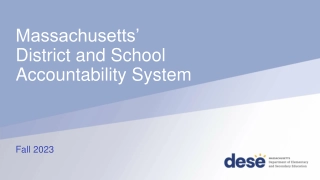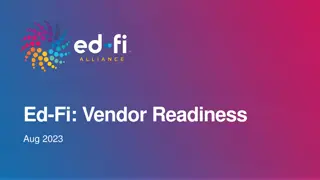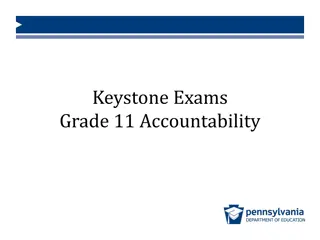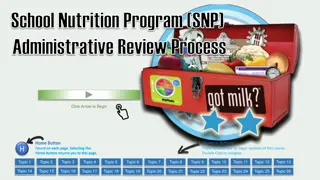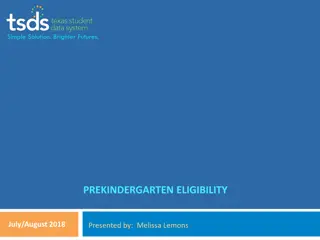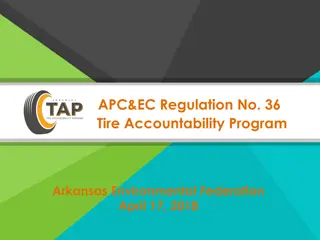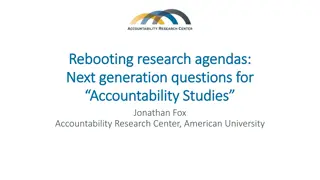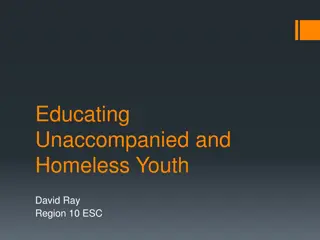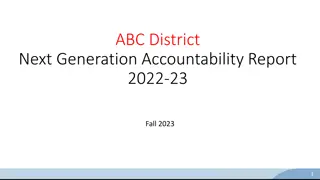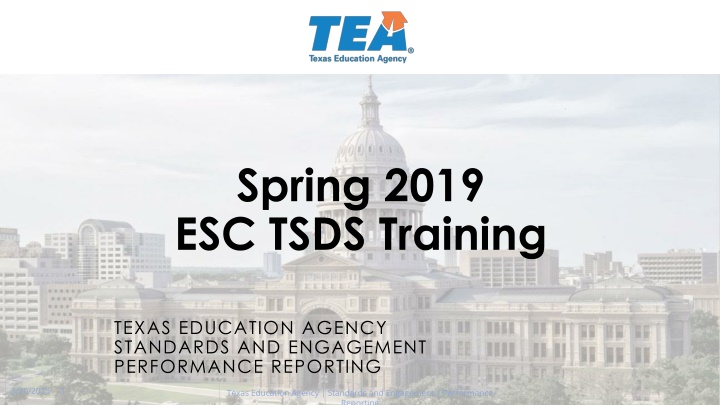
Importance of Data Quality in Education Accountability Reporting
Explore the significance of data quality in education accountability reporting, focusing on the implications of errors in data collection and reporting processes. Learn how accurate data impacts student outcomes and program evaluations in educational settings.
Download Presentation

Please find below an Image/Link to download the presentation.
The content on the website is provided AS IS for your information and personal use only. It may not be sold, licensed, or shared on other websites without obtaining consent from the author. If you encounter any issues during the download, it is possible that the publisher has removed the file from their server.
You are allowed to download the files provided on this website for personal or commercial use, subject to the condition that they are used lawfully. All files are the property of their respective owners.
The content on the website is provided AS IS for your information and personal use only. It may not be sold, licensed, or shared on other websites without obtaining consent from the author.
E N D
Presentation Transcript
Spring 2019 ESC TSDS Training TEXAS EDUCATION AGENCY STANDARDS AND ENGAGEMENT PERFORMANCE REPORTING 3/20/2025 1 Texas Education Agency | Standards and Engagement | Performance Reporting
Accountability System Data 3/20/2025 2 Texas Education Agency | Standards and Engagement | Performance Reporting
Data Sources: Appendix H of the 2019 Accountability Manual Provides data sources for all indicators broken out by category (i.e., data used in accountability, data used in distinction designations, etc.) Indicates the year(s) the data is from and which student groups are evaluated Often shows the exact numerators and denominators used in the methodology Texas Education Agency | Standards and Engagement | Performance Reporting 3/20/2025 3
Importance of Data Quality: STAAR Districts and charter schools have several opportunities to confirm and correct data submitted for accountability purposes, including a corrections window. Student demographic data is final once answer documents have been scored. Texas Education Agency | Standards and Engagement | Performance Reporting 3/20/2025 4
Importance of Data Quality: STAAR STAAR Data Example 2017 STAAR Results 2018 STAAR Results 3/20/2025 5 Texas Education Agency | Standards and Engagement | Performance Reporting
Importance of Data Quality: STAAR STAAR Data Example The county-district-campus number was not uploaded into the system that allows ETS to pre-code the answer documents. The district received multiple notifications of the irregularity but failed to resolve it. As a result, STAAR answer documents were not pre-coded with the county-district-campus number. The district did not hand-code the answer documents, so all 734 results were not correctly attributed to the district or campus. This has far-reaching implications in accountability. 3/20/2025 6 Texas Education Agency | Standards and Engagement | Performance Reporting
Importance of Data Quality: TELPAS The inclusion and exclusion of certain English learners is dependent upon correct TELPAS data. Years in U.S. schools as well as asylee, refugee, and SIFE status is used for accountability. If it is not reported correctly, it will impact exclusions. 3/20/2025 7 Texas Education Agency | Standards and Engagement | Performance Reporting
Importance of Data Quality: Economically Disadvantaged The district and campus economically disadvantaged rate, which is used in School Progress, Part B, is from the TSDS PEIMS October snapshot (as reported in the fall submission and resubmission). Whether a student is economically disadvantaged is also reported on STAAR answer documents. This information, however, is not used to calculate the percentage of economically disadvantaged students at a district or campus. It is used only to identify which students are included in the economically disadvantaged student group in the Closing the Gaps domain. 3/20/2025 8 Texas Education Agency | Standards and Engagement | Performance Reporting
Importance of Data Quality: Economically Disadvantaged STAAR answer documents are pre-populated with demographic information from the TSDS PEIMS October snapshot (as reported in the fall submission and resubmission) or from the demographic file submitted by the district. If demographic data is changed on STAAR answer documents prior to scoring, the change overrides the TSDS PEIMS data or the data from the demographic file submitted by the district. The data from the STAAR answer documents is used to classify students by student group in Closing the Gaps. 3/20/2025 9 Texas Education Agency | Standards and Engagement | Performance Reporting
Importance of Data Quality: Economically Disadvantaged The Community Eligibility Provision (CEP) under the National School Lunch Program relaxes some campus data collection requirements for the purposes of providing free and reduced lunches. The accountability system relies on an accurate count of economically disadvantaged students. For accountability, the percentage of economically disadvantaged students at a campus or district is based on TSDS PEIMS October snapshot data (as reported in the fall submission and resubmission) or the demographic file submitted by the district, not on CEP participation. Each student s economically disadvantaged status must be reported in TSDS PEIMS (E0785). 3/20/2025 10 Texas Education Agency | Standards and Engagement | Performance Reporting
Importance of Data Quality: TSDS PEIMS Districts and charter schools have several opportunities to confirm and correct data submitted for accountability purposes, including a corrections window. Once the TSDS PEIMS resubmission window has closed, the data is frozen for accountability purposes. Data corrections made in the TSDS PEIMS working collection are not used in accountability. 3/20/2025 11 Texas Education Agency | Standards and Engagement | Performance Reporting
Importance of Data Quality: College, Career, and Military Readiness The majority of CCMR data is sourced from TSDS PEIMS. To reiterate, for accountability purposes, this data is frozen after the resubmission window closes. 3/20/2025 12 Texas Education Agency | Standards and Engagement | Performance Reporting
2019 CCMR Indicators for HS, K12, and Districts College Ready Career Ready Meet criteria of 3 on AP or 4 on IB examinations Meet TSI criteria (SAT/ACT/TSIA/College Prep course) in reading and mathematics Complete a course for dual credit (9 hours or more in any subject or 3 hours or more in ELAR/mathematics) Earn an associate s degree Complete an OnRamps course and earn college credit Earn an industry-based certification CTE coherent sequence coursework completion and credit aligned with approved industry-based certifications (one-half point credit) Graduate with completed IEP and workforce readiness (graduation type codes 04, 05, 54, or 55) Earn a Level I or Level II certificate Graduate under an advanced degree plan and be identified as a current special education student Military Ready Enlist in the United States Armed Forces 3/20/2025 13 Texas Education Agency | Standards and Engagement | Performance Reporting
College, Career, and Military Readiness Data Sources Indicator Data Source(s) College Board > Research & Analysis > Performance Reporting (PR) AP IB > Research & Analysis > PR IB College Board > Research & Analysis > PR SAT ACT > Research & Analysis > PR ACT College Board > THECB > Research & Analysis > PR TSIA (results from June 2011 to October 2018) 3/20/2025 14 Texas Education Agency | Standards and Engagement | Performance Reporting
College, Career, and Military Readiness AP, IB, SAT, ACT, and TSIA results are matched to the annual graduates file from TSDS PEIMS. TSIA results are received from the Texas Higher Education Coordinating Board and matched to students on our annual graduates list using an algorithm which includes TSDS Unique ID, SSN, and a combination of first name, last name, and DOB. The results are attributed to the districts and campuses at which the students are identified as annual graduates in TSDS PEIMS. 3/20/2025 15 Texas Education Agency | Standards and Engagement | Performance Reporting
College, Career, and Military Readiness Data Sources Indicator Data Source(s) OnRamps University of Texas > Research & Analysis > PR Level I or Level II Certificate THECB > Research & Analysis > PR TSDS PEIMS: E1011 (indicates dual credit course) E1081 (indicates number of hours earned) Dual Credit TSDS PEIMS: E1589 U.S. Armed Forces TSDS PEIMS: E1586, E1592, E1593 Industry Certification TSDS PEIMS: E0031 (summer submission, code 2 in final year of enrollment) + course completion code from list of 104 courses Complete a CTE Coherent Sequence + Course Aligned with Certification 3/20/2025 16 Texas Education Agency | Standards and Engagement | Performance Reporting
Importance of Data Quality: College, Career, and Military Readiness Indicator Data Source(s) TSDS PEIMS: Course Completion Section, Code Table ID C022 ELA: Code CP110100 Math: Code CP111200 E0948 (course sequence codes of 0, 2, 5, or 9) E0949 (indicates pass/fail) College Prep Course TSDS PEIMS: E0806 (type codes 04, 05, 54, or 55) IEP and Workforce Readiness Graduates TSDS PEIMS: E1596 Associate s Degree Advanced Degree Plan & Current Special Education TSDS PEIMS: E1264 and E0794 3/20/2025 17 Texas Education Agency | Standards and Engagement | Performance Reporting
Importance of Data Quality: Common Mistake Course Sequence Codes Course sequence codes are not used to calculate dual credit hours in CCMR. Course sequence codes are used for college prep courses completion. 0 One Semester Course 6 First Fourth Of A Four Semester Course 1 First Half Of A Two Semester Course 7 Second Fourth Of A Four Semester Course 2 Second Half Of A Two Semester Course 8 Third Fourth Of A Four Semester Course 3 First Third Of A Three Semester Course 9 Last Fourth Of A Four Semester Course 4 Second Third Of A Three Semester Course A Non-High School Year Long Course 5 Last Third Of A Three Semester Course *Course sequence codes are also used in advanced coursework/dual credit course completion used in distinction designations 3/20/2025 18 Texas Education Agency | Standards and Engagement | Performance Reporting
Importance of Data Quality: At Risk Each student s at-risk status must be reported in TSDS PEIMS (E0919). The 13 at-risk criteria are defined in TEC 29.081. In order to register to be evaluated by alternative education accountability provisions, the campus must have at least 50 percent of enrollment in grades 6 12 and at least 75 percent at-risk enrollment on the TSDS PEIMS October snapshot (as reported in the fall submission and resubmission). 3/20/2025 19 Texas Education Agency | Standards and Engagement | Performance Reporting
Importance of Data Quality: Distinction Designations As with all accountability data, distinction designation data cannot be changed once it s received by Performance Reporting. Decisions regarding distinction designations cannot be appealed. 3/20/2025 20 Texas Education Agency | Standards and Engagement | Performance Reporting
Importance of Data Quality: Appeals Districts and charter schools are responsible for providing accurate information to TEA, including information provided on student answer documents or submitted via online testing systems. Districts and charter schools have several opportunities to confirm and correct data submitted for accountability purposes during correction windows. TSDS PEIMS submissions are certified as accurate by the superintendent. 3/20/2025 21 Texas Education Agency | Standards and Engagement | Performance Reporting
Importance of Data Quality: Appeals The appeals process is not a permissible method to correct data that were inaccurately reported by the district or charter school. Appeals from districts and charter schools that missed data correction opportunities are denied. 3/20/2025 22 Texas Education Agency | Standards and Engagement | Performance Reporting
Questions Resources http://tea.texas.gov/A-F https://tea.texas.gov/perfreport/resources/index.html Sign up for the Performance Reporting weekly bulletin: 3/20/2025 23 Texas Education Agency | Standards and Engagement | Performance Reporting
Performance Reporting Resources and Contacts Performance Reporting Home Page http://tea.texas.gov/accountability/ TEA ESSA Page https://tea.texas.gov/ESSA/ Local Accountability Systems Email LAS@tea.texas.gov Performance Reporting Email performance.reporting@tea.texas.gov Performance Reporting Telephone (512) 463-9704 3/20/2025 24 Texas Education Agency | Standards and Engagement | Performance Reporting

